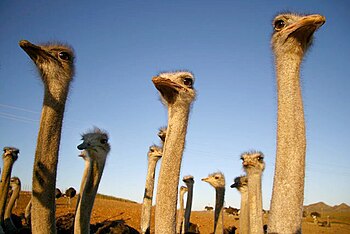Ostrich farming in the Eastern Cape of South Africa started in the early years of the 19th century. This was as a result of the high demand for ostrich feathers for use in the fashion industry.
 |
Ostriches near Swartberg Pass, Oudtshoorn, Western Cape (Photo credit: Wikipedia)
|
Enormous tracts of land in the Klein Karoo, outside Oudtshoorn, Western Cape, were fenced off and planted under Lucerne. Now the ostriches were within easy reach instead of having to hunt for them in the wild to harvest the ostrich feathers. Now the ostrich feathers were gathered yearly instead of shooting the birds.
Ostrich feathers were first exported in 1838, and slowly the industry became more organized until it truly organized in 1863. Eventually, by 1913, ostrich feathers were South Africa's 4th largest export, the top three being gold, diamonds, and wool. Ostrich feathers were selling at an incredible £12 per lb. (454g). This was an enormous sum, considering that a teacher was earning a mere £ 100 a year. Ostrich farming was definitely a lucrative venture, making the owners incredibly wealthy. They built large homes for themselves, which became known as "Feather Palaces".
At this stage, many other nations wanted a share in this lucrative business, and ostriches were exported to Australia and the United States. But the boom was not to last. With the outbreak of WW1, nearly all available ships were commandeered by the war effort. The advent of the motor vehicle also diminished the demand for feathers. With the collapse of the market for ostrich feathers, most of the ostriches in Australia were released into the wild.
It was only after the end of WW2 that ostrich farming in South Africa gained momentum again. Now ostrich skins were marketed as a high-value commodity. Ostrich skins were sold in low quantities but at a high value. Ostrich meat was also marketed as biltong, and as a healthy alternative to red meat. By 1959 a single channel co-operative was established, under which only the cooperative could market ostrich products. Farmers were forced to sell all their birds to the cooperative, who then marketed the different lines of ostrich products. In 1964 the first ostrich abattoir was built. All ostrich skins were shipped to England for tanning until 1970 until the first tannery was opened.
Farmers were very frustrated at the cF320ontrol that was being exercised on the market by the single channel co-operative. Production was forced to a minimum to keep prices of the ostrich skins at a maximum. Many farmers were unable to join because of this control, and they began the development of ostrich farming in Zimbabwe and Namibia. Finally, in 1993, single channel marketing was abolished, leaving farmers free to sell their products wherever they desired, for whatever price they could get.
Ostrich farming in the rest of the world has been stocked out of the free trade areas of Zimbabwe and Namibia, and by ostrich eggs and live birds that were smuggled out of South Africa.
Alan B. Stables is a freelance writer on alternative agriculture, has organized the World Ostrich Congress in Madrid, Spain in 2005 and has also been a guest speaker in Brazil, China, Egypt, Italy, Latvia, and Spain, on how to market ostrich produce for maximum returns. His leaflet "The Information Guide on How To Remove, Store, Transport and Grade Your Ostrich Skins" has become an Ostrich Industry Standard that has been translated and used in many countries today. Alan is also a founding member of the World Ostrich Association.
|

No comments:
Post a Comment